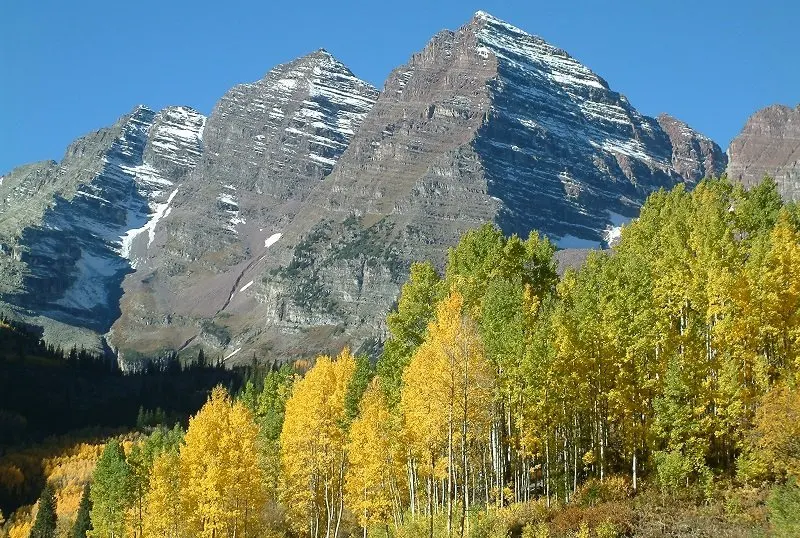The Maroon Bells have two peaks in the Elk Mountains, Maroon Peak and North Maroon Peak, separated by about half a kilometer (one-third of a mile). The mountains are on the border between Pitkin and Gunnison counties, Colorado, United States, about 12 miles (19 km) southwest of Aspen. Both peak at fourteen. Maroon Peak, at 14,163 feet (4,317 m), is the 27th highest peak in Colorado. North Maroon Peak, at 14,019 feet (4,273 m), is the 50th tallest (depending on how you count them).
 |
| Maroon Bells Colorado |
The view of Maroon Bells southwest of Maroon Creek Valley is very heavily photographed. The peaks are located in the Maroon Bells–Snowmass Wilderness in the White River National Forest. The Maroon-Bells-Snowmass Wilderness was one of five areas in Colorado designated as wilderness in the original Wilderness Act of 1964. This wilderness surrounds the extremely popular Maroon Bells Scenic Area, which is the main access point for wildlife travel.
 |
| Maroon Bells Colorado |
The name Maroon Bells, in particular, refers to the two mountains (Maroon Peak and North Maroon Peak) in the wilderness area. These peaks have become the main subjects of postcards and brochures featuring Colorado's picturesque landscape. Indeed, the Maroon Bells-Snowmass Wilderness will amaze everyone with its beautiful alpine lakes, granite peaks, alpine meadows, and streams.
In addition to the Maroon Bells, the presence of towering peaks that can reach 4,200 meters is the reason why thousands of hiking and mountaineering enthusiasts come here every year. But before you go hiking, keep in mind that the Maroon Bells are among the toughest mountains in Colorado. Climbing means constantly keeping an eye on loose, choppy rock and traversing steep inclines.
 |
| Maroon Bells Colorado |
If you don't want to go all the way to Maroon Bells, continue to Maroon Lake and capture the beautiful reflection of the mountains on the surface of the lake. Seeing this exceptional reflection is not a bad consolation! At Maroon Lake, you'll find trails that lead to other notable natural lakes like West Maroon Creek, Snowmass Lake, and Crater Lake. Other notable viewpoints and destinations in the park include Capitol Peak and Pyramid Peak.
An iconic attraction in the Maroon Bells – Snowmass Wilderness is Electric Pass, which is the highest pass in Colorado accessible by foot. The pass is very popular due to its amazing views of the Elk Mountains. You can access it via the Cathedral Lake Trail from Castle Creek Road. The only drawback to taking this trail is that it is incredibly popular and heavily used. That's why the Forest Service doesn't recommend it on weekends.
 |
| Maroon Bells Colorado |
Other hiking trails you should consider hitting include West Maroon Pass in Scholfield Park and the Maroon Bells 4 Pass Loop. The Maroon Bells 4-step loop is particularly difficult as you have to cover a 45km round trip. This means you'll need to spend 4-5 days to complete it, but it's well worth the effort as the trail is one of the most scenic in Maroon Bells. Before leaving for the wild interior; Carry a detailed map to guide you as the area is vast and without a guide getting lost along the way is definitely a possibility.
The most common access point to the Maroon Bells – Snowmass Wilderness is the Aspen area. From Aspen, you need to drive west and follow Hwy 82. Lake Maroon has a designated parking lot, but it usually fills up quickly during peak tourist season. If parking is not available near the lake area, shuttle services are usually offered to potential visitors. Transportation tickets are available at the Aspen Highlands Sports Shop.
Maroon Bells: Snowmass Wilderness is at its most scenic in the height of summer and fall. The months of July and August are special because the wildflowers are in full bloom at this time, but the dramatic color change at the end of September is just as impressive. If you want to avoid the crowds, plan to visit the area very early in the morning on weekdays. Try to avoid a visit on weekends and holidays unless you have a lot of patience.